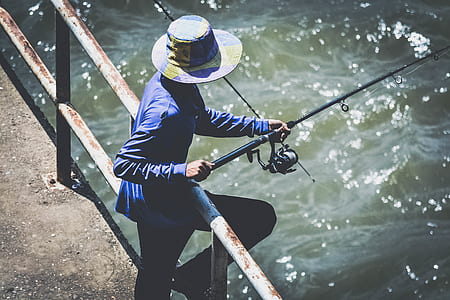How To Cast A Fly Rod For Beginners: Best Rolling Techniques And Throwing Styles
Students are sure they are going by way of the precise motions, but the road nonetheless refuses to go the place it's supposed to. Although I still choose an eight 1/2 foot rod as an all around spring creek rod (and a 9 footer on huge tailwaters like the Missouri or Bighorn), I discover a 7 foot rod to be ultimate for small mountain streams or tiny spring creeks.
 What we like as effectively is the collapsible handle that allows you to stash it in your knapsack, caravan, and even the boot of your car. If that video didn’t clear issues up, you'll be able to always take a look at this resource from RIO as effectively. Surf Casting Rods begin at around 11ft lengthy and, just like the Continental Surf Rods described above, will be as long as 16 ft.
What we like as effectively is the collapsible handle that allows you to stash it in your knapsack, caravan, and even the boot of your car. If that video didn’t clear issues up, you'll be able to always take a look at this resource from RIO as effectively. Surf Casting Rods begin at around 11ft lengthy and, just like the Continental Surf Rods described above, will be as long as 16 ft.
The advantages of short rods repeated in dozens of angling texts - more portability when hiking by brush and simpler false casting underneath overhanging branches-are legitimate, but they aren't practically as vital as the accuracy afforded by moving the trail of the rod tip nearer to the caster’s line of sight.
For my part, this can be a common failing of much casting instruction: we strive to teach mechanics (stance, grip, angles of wrist and elbow, size of the casting arc, and many others.) to students who don’t perceive their relationship to the path of the rod tip - and ultimately, what actually matters - management of the casting loop.
And after you have all of your essential fly fishing gear collectively, studying the fly casting basics is your subsequent step. You have to search out the best temperature and present greatest for fishing. If the caster separates the plane of the back cast and ahead solid, he should make the again forged barely sidearm and bring the forward cast proper down the line of sight for better accuracy.
I teach this to students by getting them to look at the goal and make an overhead solid (a minimum of on the ahead stroke) down their line of sight. The Tuck Cast is used to assist remedy one among the largest challenges in nymph fishing getting your flies to sink to the bottom as quick as attainable. Getting the proper forged won't occur in a single day, but the large fish rewards are worth the hassle.
Trout who see fly lines flash above them will get spooked, and it’s the older and larger fish that will likely be probably the most conscious. For instance, false casting is an excellent diagnostic device to see where your casting can enhance. This may seem very fundamental, however most of the accuracy problems I see on the stream consequence from excessively sidearm casting motions.
Reach Casting - This is a useful solid if you find yourself casting your fly throughout water that has a number of present speeds stopping the fly from going downstream quicker than water that it has landed on. This can trigger your chief and flies to show over completely and along with your flies landing within the water before the road.
You possibly can apply a roll forged with out being on the water If you happen to tie your individual chief. One of the crucial useful casts you can learn the roll solid is at the top of the list for its versatility and success in catching fish. Canting the rod doesn’t cure tailing loops, nevertheless it does keep the road and leader from tangling, because the crossed loops unroll alongside (slightly than on prime of) one another.
But Ray doesn’t need an Ivy League study to inform her that. You'll want to know your abilities and have the ability to measure your progress as you observe. Should you were utilizing a 2 ounce sinker for a 1 to 2 foot wave you then might need a 5 ounce sinker for a four to six foot wave.
The wrist hinges backwards, and then you definately point the rod at the 2:00 o’clock point, and extend your arm in direction of the goal. I find that many casters obtain better accuracy and management by visualizing the trail of the rod tip itself, adjusting hand and arm place as essential to drive the tip down one’s line of sight.
Joan Wulff, in her excellent e-book Fly-Casting Accuracy (The Lyons Press, 1997, 96 pages), makes use of the time period “eye/goal line” to discuss with line of sight and “hand/target line” as the trail the caster’s hand takes to drive the rod tip towards the target. While that is an insightful conceptualization of the components of accuracy, my own experience in educating casting is that many college students - particularly newcomers and intermediates - fail to regulate the connection between the hand/goal line and the path of rod tip during the casting stroke.